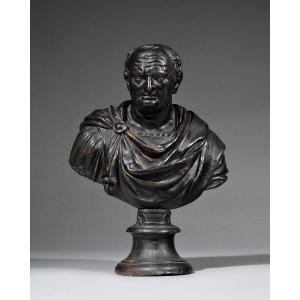Clock, The Vigilance.
Biscuit, porcelain base imitating tortoiseshell and omolu applique decoration.
Between 1790 and 1800.
A winged figure holding a flame in one hand sits cross-legged, the other hand rests over a rooster on a book, an oil lamp next to it. The tortoiseshell porcelain base is decorated with ormolu symetrical elements representing a grotesque mask, two roosters and a flame.
In the inventory made after Christophe Dihl's death in 1830 a model by Lemire is mentioned, among the models used by the manufacture of the Duke of Angouleme. This clock representing the Vigilance had been created Charles-Gabriel Sauvage, known as Lemire (1741 - 1827). It is also mentioned in the sale’s catalogue of the models having been used by the manufacture.
The biscuit iconography indicates that our model is most likely this clock. Indeed, the rooster, the oil lamp, the flame and the wings of the allegory are attributes commonly given to the Vigilance.
Moreover, the imitation of tortoiseshell on the base is similar to the base that adorns a bust of Bonaparte sold by Bonhams on October 27th 2021 for £50,000, also mentioned in the after-death inventory, and signed with the mark of Dihl and Guerhard.
Another clock from the Duke of Angoulême manufacture, whose biscuit subject represents Eros desarming Hercules, cited and illustrated in specialist Régine de Plinval de Guillebon's book, Les biscuits de porcelaine de Paris, XVIIIe-XIXe siècles, presents exactly the same palmette frieze with a tortoiseshell background as ours.
The specific clocks from Paris produced at the end of the Ancien Régime are commonly composed of a biscuit figure or group and they often rest on a colored or decorated base. Allegories were treated as figures or groups inspired by the antique. They became the vector of revolutionary values and then of those of the Empire from the end of the 18th century. The allegory of Vigilance is linked to war, the wings symbolize speed, the rooster is the animal that keeps you awake and the torch and the oil lamp guide you in the darkness.
In 1781, the deed of partnership that gave birth to the Dihl and Guerhard porcelain factory was signed between Christophe Dihl and the Guerhard couple, Antoine and Louise-Marie-Madeleine. Opened under the patronage of the Duke of Angouleme, nephew of King Louis XVI, this protection ensured them the right to create enameled and colored porcelain pieces in spite of the monopoly that the Sèvres manufactory held until then on this production.
Created under the Ancien Régime, this factory went through the Revolution, the Consultat, the Empire before dying out under the Restoration in 1828. Innovative, thanks to the technical ingenuity of Dihl and the commercial clairvoyance of the Guerhard couple, it was successful from the start and already employed twelve sculptors and thirty painters in 1785. Throughout the neoclassical period, it became the main competitor of the Sèvres factory with its use of a wide range of colors for enamels, the exquisite delicacy of its biscuits and its elaborate ornamentation.
From the end of the Ancien Régime, the manufacture of the duke of Angouleme sold sumptuous "clocks in beautiful biscuit" (Peuchet, year VIII, t.V, p. 325. Universal dictionary of the commercial geography). There are 65 models of clocks in the inventory after Dihl's death although few of them are identified today. Many models are due to Lemire, a well-known sculptor who regularly exhibited at the Salon between 1793 and 1819. Among these models, we find the child reading and the child drawing which have been reproduced a lot. But our clock is one of the few other biscuits models of the sculptor to have survived.
The quality of the pieces produced has been recognized as equaling, and sometimes surpassing, that of Sèvres. When in 1790 George Washington asked his representative in France, Governor Morris, to bought porcelain for him, Morris noted in his diary that he had visited the Duke of Angouleme's factory: "We find the porcelain here more elegant and cheaper than that of Sèvres." He also acquired a tableware set for Washington, some of which is still in the Mount Vernon Museum and the Philadelphia Museum of Art.
The manufactory was distinguished by the great variety of pieces it was allowed to produce thanks to royal protection: tableware, clocks, biscuits groups, paintings on porcelain... These paintings required a technical virtuosity brought to its peak by Dihl which earned him an award at the Exposition des Produits de l'Industrie in the year V (1797-1798). In the same year, he married Louise-Marie-Madeleine Guerhard, who had been widowed.
The imperial period marked the peak of the factory’s resounding success with the 1806 Exhibition of Industrial Products and the Salon. By carefully selecting the best specialists for each position, it ensured a production of exceptional quality and employed up to two hundred workers.
However, the economic crisis caused by the Napoleonic wars, combined with the continental blockade set up by the adversaries of the Empire, pushed the factory on a long downward slope. It couldn’t survive without selling aboard, especially to Spain, England and Russia. In spite of the courageous struggle of the aging couple, the company was dissolved by the court in 1828, two years before Dihl died in 1830, followed by his wife in 1831. All the assets of the factory were dispersed in auctions, two of which were devoted to the most beautiful pieces.



















 Le Magazine de PROANTIC
Le Magazine de PROANTIC TRÉSORS Magazine
TRÉSORS Magazine Rivista Artiquariato
Rivista Artiquariato
